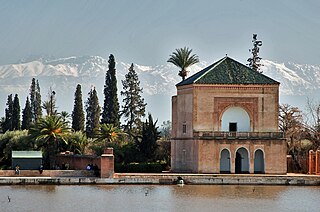
Marrakesh or Marrakech is the fourth largest city in Morocco. It is one of the four imperial cities of Morocco and the capital of the Marrakesh–Safi region. It is west of the foothills of the Atlas Mountains.

A riad or riyad is a type of traditional Moroccan and Andalusi interior garden or courtyard associated with house and palace architecture. Its origin is generally attributed to Persian gardens that spread during the Islamic period. The term is nowadays often used in Morocco to refer to a hotel or guesthouse-style accommodation with shared common areas and private rooms, often within a restored traditional mansion.
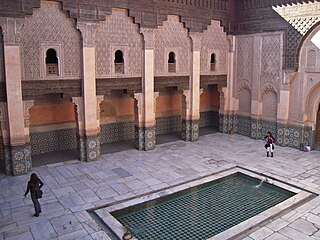
Abdallah al-Ghalib Billah was the second Saadian sultan of Morocco. He succeeded his father Mohammed al-Shaykh as Sultan of Morocco.
Abu Abdallah Muhammad ibn Abd al-Rahman al-Qaim bi-Amr Allah, often shortened to Abu Abdallah al-Qa'im or Muhammad al-Qa'im, was the first political leader of the Saadi Dynasty of Morocco. He ruled the Sous and other parts of southern Morocco from 1510 to 1517, setting the stage for his sons to lead the dynasty to power over the rest of Morocco in the decades after his death.
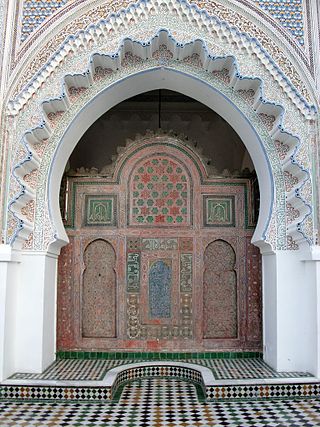
'Anaza or anaza refers to a short spear or staff that held ritual importance in the early period of Islam. The term gained significance after the Islamic prophet Muhammad planted his spear in the ground to indicate the direction of prayer (qibla). Over time, 'anaza evolved into an architectural term denoting an outdoor mihrab in mosques, particularly in the Maghreb region.

The Shrob ou Shouf Fountain or Chrob ou Chouf Fountain is a historic wall fountain in the medina of Marrakech, Morocco. It dates from the late 16th or early 17th century and is located near the Ben Youssef Madrasa.
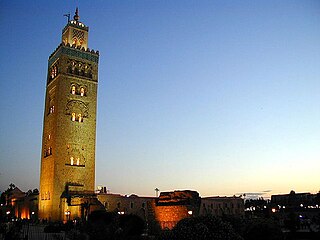
This article describes notable landmarks and architecture in the city of Marrakesh, Morocco.

The Ben Youssef Mosque, is a mosque in the Medina quarter of Marrakesh, Morocco, named after the Almoravid emir Ali ibn Yusuf. It is arguably the oldest and most important mosque in Marrakesh.

The Kasbah Mosque is a historic mosque in Marrakesh, Morocco. It was originally built by the Almohad ruler Yaqub al-Mansur in 1185-1190 CE. It is located in the Kasbah district, the city's former citadel, near the site of its historic royal palaces. Along with the Kutubiyya Mosque, it is one of the most important historic mosques in Marrakesh.

The Bab Doukkala Mosque or Mosque of Bab Doukkala is a major neighbourhood mosque in Marrakesh, Morocco, dating from the 16th century. It is named after the nearby city gate, Bab Doukkala, in the western city walls. It is also known as the al-Hurra Mosque.

The Mouassine Mosque or al-Muwassin Mosque is a major neighbourhood mosque in Marrakech, Morocco, dating from the 16th century during the Saadian dynasty. It shares its name with the Mouassine neighbourhood.

The Zawiya of Sidi Abd el-Aziz is an Islamic religious complex (zawiya) in Marrakesh, Morocco. It is centered around the tomb of the Muslim scholar and Sufi saint Sidi Abu Faris Abd al-Aziz Abd al-Haq at-Tabba', who died in Marrakesh in 1508. Sidi Abd el-Aziz is considered one of the Seven Saints of Marrakesh, and his tomb was a prominent stop for pilgrims to Marrakesh. The zawiya is located on Rue Mouassine at its intersection with Rue Amesfah.

The Zawiya of Sidi Muhammad Ben Sliman al-Jazuli is an Islamic religious complex (zawiya) in Marrakesh, Morocco. It is centered around the tomb of the 15th-century Muslim scholar and Sufi saint Muhammad al-Jazuli, who is one of the Seven Saints of Marrakesh.

The Kasbah of Marrakesh is a large walled district in the southern part of the medina of Marrakesh, Morocco, which historically served as the citadel (kasbah) and royal palace complex of the city. A large part of the district is still occupied by the official royal palace, the Dar al-Makhzen, which serves as the residence of the King of Morocco when he visits the city. The rest of the district consists of various neighbourhoods and monuments. It was founded by the Almohads in the late 12th century, with most of the construction carried out by Caliph Ya'qub al-Mansur. Two of its most important surviving structures today, the Kasbah Mosque and the main gate of Bab Agnaou, date from al-Mansur's reign.

Sidi Yusuf ibn 'Ali as-Sanhaji is a wali who was born in Marrakesh, Morocco and died there in 1196 CE. He is considered one of the Seven Saints of Marrakesh, and one of the administrative divisions of Marrakesh is named after him.
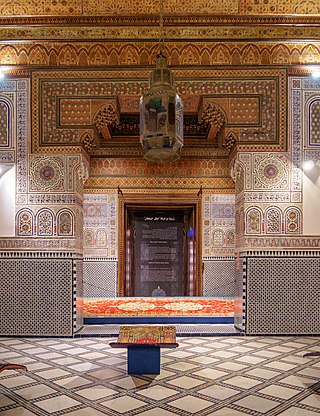
Dar Si Said is a historic late 19th-century palace and present-day museum in Marrakesh, Morocco.

The Mouassine Museum is a museum in the Mouassine neighbourhood of the historic medina of Marrakesh, Morocco. The museum is housed in a recently restored 16th to 17th-century house which includes an upper-floor apartment known as a douiria. It was recently converted to a Museum of Music, with permanent and temporary exhibits.
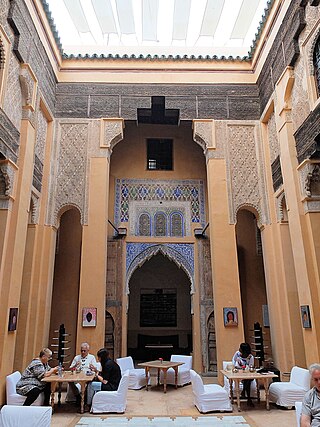
Dar Cherifa, historically known as Dar Ijimi, is a late 16th-century house in the medina of Marrakesh, Morocco. It is located in the Mouassine neighbourhood and is one of the few well-preserved houses from the Saadian period in the city. In recent years it has been restored and is now used as a café and art gallery.

The Mouassine Fountain is a part of the 16th-century religious complex of the Mouassine Mosque in Marrakesh, Morocco. The tradition of building public fountains in Marrakesh is old but took on a very monumental character in the Saadian era.




















